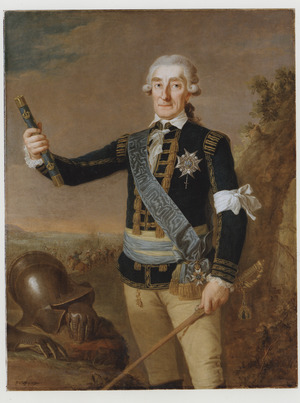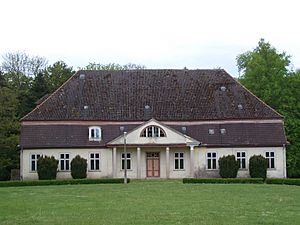Johan August Meijerfeldt the Younger facts for kids
Count Johan August Meijerfeldt (born May 4, 1725 – died April 21, 1800) was an important Swedish military leader. He became a field marshal, which is a very high rank in the army. People often call him Johan August Meijerfeldt the Younger to tell him apart from his father, who had the same name.
He spent many years in the military, fighting in wars both for Sweden and for other countries. He served in the Pomeranian War and the Russo-Swedish War. By the end of the Russo-Swedish War, he was in charge of all Swedish ground forces in Finland. He was promoted to field marshal right after the war ended. He was married to Louise Meijerfeldt.
Contents
A Military Leader's Life
The Meijerfeldt family originally came from a region called Livonia. Johan August Meijerfeldt the Younger was born in Stralsund, a city in Swedish Pomerania, on May 4, 1725. He started his military career at a young age. By 1737, he was already serving in a military group in his hometown.
Early Military Adventures
In 1744, he became a captain. The next year, he got special permission to leave Sweden. He went to fight in the War of the Austrian Succession alongside Austria. He fought against Prussia and later against France. He took part in big battles like the Battle of Soor and the Battle of Kesselsdorf. In 1746, French soldiers captured him. After he was set free, he went back to Sweden.
Serving the Queen and Other Wars
When he returned to Sweden, he became a trusted friend of Queen Louisa Ulrika. He even helped her try to get money from other countries. This money was for her plan to take power in 1756, but her plan failed. After the failed plan, Meijerfeldt was briefly arrested and questioned. However, he didn't face serious punishment.
He left Sweden again to fight in the Seven Years' War. This time, he fought for Brunswick. He was part of the Battle of Hastenbeck in 1757. When Sweden joined the war, he came back home and joined the Swedish army. He led troops in battles around places like Peenemünde, Güstrow, and Wolin during the Pomeranian War. In 1759, he was promoted to lieutenant colonel.
Political Life and Later Wars
Meijerfeldt was also involved in Swedish politics during the 1760s, 1770s, and 1780s. When the Russo-Swedish War began in 1788, he returned to active military duty. At first, he led a group trying to capture Hamina. This effort failed because they didn't have enough supplies or ammunition.
After a group of officers called the Anjala conspiracy caused trouble, Meijerfeldt was put in charge of the forces near Anjala. In December 1788, he was given overall command of all ground forces in Finland. This happened while the king was away. In this role, he recaptured Karkkila in July 1789. He also stopped Russian forces from gaining more land in Finland.
When the war ended with the Treaty of Värälä, he received his highest promotion: field marshal. Soon after the war, he retired from the military. He disagreed with King Gustav III's increasingly strict way of ruling. He spent most of his remaining life at his family home in Nehringen in Pomerania.
He married Louise Meijerfeldt in 1763. Johan August Meijerfeldt died in Stockholm on April 21, 1800.
Awards and Honors
- Order of the Seraphim (1797) - This is one of Sweden's highest honors.



